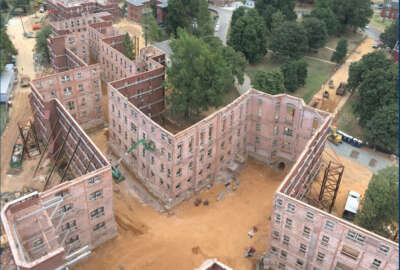

The Federal Emergency Management Agency has abandoned plans to relocate to the St. Elizabeths campus, but another wave of DHS components plans to move in over the...
Best listening experience is on Chrome, Firefox or Safari. Subscribe to Federal Drive’s daily audio interviews on Apple Podcasts or PodcastOne.
The Department of Homeland Security’s vision of a unified agency, working out of a single headquarters campus in the Washington D.C. metro area, appears more out of reach than when it was first considered over a decade ago.
The Federal Emergency Management Agency has walked away from plans to relocate to the St. Elizabeth’s campus in Southeast D.C. But in its place, another wave of DHS components plan to move in over the next few years. Still, the project faces considerable hurdles before coming to a close.
DHS and the General Services Administration had asked Congress for hundreds of millions of dollars this year to fund a FEMA headquarters at the ongoing St. E’s campus, but with the project facing continued budget shortfalls and schedule delays, FEMA will now take up residence in long-term leased office space, rather than move to the consolidated campus.
DHS Undersecretary for Management Randolph “Tex” Alles told Federal News Network in an interview Friday that circumstances remain “a little bit of an unknown on the FEMA side,” but added that the agency is looking for long-term leasing options for FEMA.
Those options include extending the lease on office space it currently occupies in Southwest D.C. or moving FEMA personnel to the National Capital Region Building that GSA owns near L’Enfant Plaza.
“We’re not entirely sure we can renew the lease at the current location, and if that does not occur, we’ll have to look for new commercial property. And that may or may not be in the NCR,” Alles said.
The building already houses some DHS personnel, and GSA will soon relocate more than 1,000 employees from the NCR building to the agency’s headquarters building at 1800 F St. NW.
This strategy, Alles said, resembles the approach taken by the Transportation Security Agency and U.S. Citizenship and Immigration Services, both of which will not be relocating to the St. E’s campus, but will instead build their own headquarters.
TSA in August 2017 announced it would move its facilities to Springfield, Virginia, while USCIS in October 2017 broke ground on its future headquarters in Camp Springs, Maryland. The latter construction project would consolidate about 3,000 employees from six different locations around the D.C. metro area.
But FEMA’s decision to walk away from the St. E’s campus reflects difficulties DHS and GSA have had in managing budget shortfalls while still trying to bring a critical mass of employees to the campus.
Kristi Tunstall Williams, the director of GSA’s historic preservation and arts division, told the National Capital Planning Commission last week that since the St. E’s project began in the mid-2000s, Congress has only given GSA 43% of the funds it has requested for construction.
Amid campus construction delays, component agencies also have to act on deadlines for soon-to-expire building leases.
A GSA spokesperson said FEMA currently resides in two buildings at 400 C St. and 500 C St. SW. The spokesman added that those leases expire in January 2021 and August 2020, and confirmed that the agency is “working on a long-term plan for housing FEMA.”
The decision to pull the plug on FEMA’s move to St. E’s came after Congress set aside $120 million for the St. E’s campus in the FY 2019 spending bill. That amount fell short of the $171.1 million DHS requested to build a new FEMA headquarters on the campus.
Under the old St. E’s plan, GSA and DHS expected to receive full funding for a new FEMA headquarters in fiscal 2017, but Congress also shortchanged the agencies’ funding request in spending bills for FY 2017 and 2018. That funding shortfall created a domino effect of delays for other construction projects on the campus.




Despite the murky future of FEMA’s long-term residence, employees working out of the St. E’s campus will soon have some new neighbors.
DHS and GSA expect to complete construction on an addition to the St. E’s Center Building by February 2020. The addition will enable DHS to relocate staff from its Office for Civil Rights and Civil Liberties, its privacy office, front-office personnel from its Office of Intelligence and Analysis (I&A) and computer support staff with the office of the Chief Information Officer.
While a revised master plan for the campus remains a work in progress, a DHS representative told Federal News Network that the Cybersecurity and Infrastructure Security Agency will move into a newly constructed facility on the campus in fiscal 2023. The cyber agency is currently situated in more than eight locations around the D.C. metro area.
A second new building will house the rest of the I&A office by FY 2024, and a third will accommodate Customs and Border Protection, as well as Immigration and Customs Enforcement, by FY 2025. The completion date for St. E’s has been a moving target, but DHS officials have told Congress it expects to wrap up the project by 2026.
Once DHS and GSA complete this wave of construction and relocation, the DHS representative said more than 13,000 employees will work out of St. E’s, nearly the final headcount GSA envisioned for the campus in 2013. That new construction, however, will come at the sacrifice of as many as five historic St. E’s buildings.
Williams said GSA has made it a priority to strike a balance between preserving the historic landmark and giving DHS the infrastructure it needs to carry out its mission.
“GSA is committed to ensuring that we don’t do any demolition before we have full construction funding to build anything, because as we know, the whole world could change,” Williams told the NCPC last Thursday.
Because the entire site is a historic landmark, GSA has had to work with D.C. preservation regulations, including maintaining the exterior facades of major buildings. As a result, GSA has spent at least $305 million for adaptive reuse on the campus.
GSA and DHS achieved a significant victory on the campus in June, when leadership from both agencies held a ribbon-cutting for the pre-Civil War Center Building, which houses the Office of the Secretary and more than 1,000 DHS personnel.
“What has happened, and what we predicted would happen, is now that the secretary is on campus in the Center Building, they realize it’s not so bad to be in this historic building,” Williams said. “Everyone wants to be there now, so people are interested in coming.”
The St. E’s project, however, remains an ongoing concern for some members of Congress.
Sen. Rand Paul (R-Ky.) this summer highlighted the St. E’s project in his annual report of wasteful federal spending. Citing GSA briefings with the Federal Spending Oversight Subcommittee that Paul chairs, the report found that up to 30% of the campus was subject to “anticipated slope instabilities.”
According to the report, GSA officials also learned in 2010 that some of the buildings on the campus “lacked adequate foundations, and some were literally sinking into the ground.”
“If you want to turn an historical mental institution into a high-tech and secure government facility, you will face a multitude of problems along the way,” the report states.
NCPC members approved GSA’s plans for new construction and the demolition of historic buildings, but commission members remain concerned about the direction the government construction project, the largest of its kind since the Pentagon, has taken over the years.
NCPC Vice Chairman Thomas Gallas said construction of three new buildings on the St. E’s campus marked a significant departure from the master plan the commission approved in 2009, but said the commission remains supportive of preserving the historic nature of the campus.
“We understand why it’s happening, and we understand that the process that you’ve gone through has yielded, I think, the best possible result, given the circumstances,” Gallas said.
What the commission doesn’t want to see, he warned, is a “bait and switch,” or yet another major departure from the revised master plan once it’s completed next year.
“What would keep you from coming back in 10 years and saying, ‘Oh, well gee, now we have our new buildings and Congress won’t fund renovation of these historic buildings, let’s tear them down.’ You know, it’s not that different than what we’re doing here today,” Gallas said.
Copyright © 2025 Federal News Network. All rights reserved. This website is not intended for users located within the European Economic Area.
Jory Heckman is a reporter at Federal News Network covering U.S. Postal Service, IRS, big data and technology issues.
Follow @jheckmanWFED
